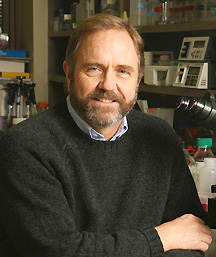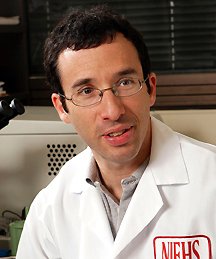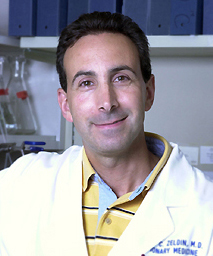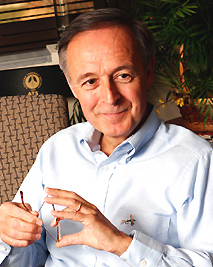
| T H E N I H C A T A L Y S T | J A N U A R Y – F E B R U A R Y 2007 |
|
|
|
|
NIEHS
LAUNCHING AN OUTPATIENT CLINICAL
RESEARCH UNIT |
by
Eddy Ball,
NIEHS
|
 |
Architectural design has begun on what will be the first Clinical Research Unit (CRU) at the NIEHS campus in Research Triangle Park, N.C.
Groundbreaking is anticipated in early spring, and researchers expect to begin working in the new 11,500-square-foot facility this summer.
It was at first thought that CRU studies would focus on environmental lung diseases such as asthma for which there is abundant evidence on the role of exposure to airborne materials. But investigators have been proposing an expanded research portfolio that includes epigenetics, cardiovascular disease risk, and reproductive health. (Studies already planned or proposed—and awaiting IRB approval and/or funding—are listed below.)
 |
|
Perry
Blackshear, director of clinical research
|
 |
|
Michael
Fessler, head of the Host Defense group
|
 |
|
Darryl
Zeldin, senior scientist
|
 |
|
William
Martin , director of translational research
|
|
CRU
Research
|
Projects and People
The CRU will provide the institute with unprecedented resources for clinical research: Previously, NIEHS research involving human tissue sampling or functional assessment could not be performed on the main campus. The new facility is situated adjacent to the main laboratory and will permit physician-scientists to conduct studies that involve on-site sample collection, pulmonary function assessment, and laboratory analysis.
The CRU will accommodate outpatient research only and will offer routine patient evaluation, fluoroscopy, X-ray and ultrasound imaging, and sample collection and processing. It will also feature specialized diagnostic and analytical capabilities, such as inhalation-exposure measurement and bronchoscopy with bronchial sampling.
The new facility, notes Perry Blackshear, director of clinical research, "overcomes a geographical obstacle for investigators who have wanted to engage in clinical research, [and] it will allow our clinical research to expand in new directions."
Blackshear, an endocrinologist and PI in the Polypeptide Hormone Action Group in the Laboratory of Neurobiology, was a key figure in the development of the CRU and will direct its operations and future expansion. He is also one of the NIEHS investigators eager to stroll between his lab and the CRU.
"We’ve established a large DNA registry, the Environmental Polymorphism Registry, for which we have subject identifiers. With the new unit," Blackshear says, "we can bring subjects in for blood cell collection to investigate possible physiological or biochemical changes related to the polymorphisms."
Michael Fessler, head of the Host Defense Group, and Darryl Zeldin, a senior scientist—both of whom are pulmonary and critical-care specialists in the Laboratory of Respiratory Biology—express similar enthusiasm.
"Our group’s initial studies at the CRU," says Zeldin, "will be a direct outgrowth of prior epidemiological and laboratory studies and will involve assessment of human subjects that [before] would not have been possible."
Zeldin and his colleagues will use the CRU to collect blood, saliva, and DNA samples and to conduct periodic assessments of asthma symptoms and lung function, as well as noninvasive assessment of vascular function. They will use their laboratory to examine oral bacteria and other samples.
"The overall strategy," Fessler says of his group’s intended use of CRU resources, "will be to partner cell, laboratory animal, and human models of lung disease to discover and validate new aspects of disease induction."
Both Zeldin and Fessler will take a disease-oriented translational approach to develop potential clinical applications out of their group’s work on the mechanisms of infection, inflammation, and induction of the lung’s preprogrammed immune response to the environment.
For NIEHS researchers, the CRU expands the traditional concept of what a laboratory is. The unit is a laboratory in its own right, a controlled setting for asking a focused question, as well as an extension, both physically and conceptually, of the institute’s existing lab resources. It provides what Fessler calls "an extra tier in the bench-to-bedside spectrum" and could even one day serve as a repository of preserved human specimens for future studies.
Bethesda Presence and Collaborations
Despite having relatively few researchers based in Bethesda and the difficulties of long-distance research, NIEHS has maintained a research agenda at the NIH Clinical Center oriented primarily toward autoimmune diseases. NIEHS investigators anticipate continuing these activities, at least for the foreseeable future, as North Carolina-based investigators expand clinical research on-site.
Although NIEHS has a long history of collaboration with sister NIH institutes, initial studies at the CRU will follow the more routine collaboration patterns involving universities and private partners.
William Martin, director of translational research, emphasizes, however, that interinstitute collaboration at the CRU will also become a more attractive option as the facility expands.
"One of our overarching goals is to integrate our science with the work of other institutes and other federal agencies," he says.
In addition to expanding multisite studies with sister institutes to include clinical research, Martin anticipates the development of "sophisticated technologies and unique resources that others at NIH would be willing to travel [to North Carolina] to use."
A Reflection of NIEHS’ Future
According to Martin, the CRU will encourage NIEHS scientists and grantees to develop protocols that promote interdisciplinary research at various levels. He sees the CRU as a tangible and evocative "metaphor for the changes that are happening within the institute in terms of the Strategic Plan."
"There’s nothing quite like a building to say that we are going in a new direction," Martin observes.
The CRU is expected to influence scientific culture at the institute and to advance several of the goals set in the NIEHS 2006 Strategic Plan:
![]() Enhancing the impact of intramural research on understanding human health and
disease in a "bidirectional" feedback process between basic science
research and clinical research
Enhancing the impact of intramural research on understanding human health and
disease in a "bidirectional" feedback process between basic science
research and clinical research
![]() Providing a model for applying basic science to problems in clinical research
in environmental health
Providing a model for applying basic science to problems in clinical research
in environmental health
![]() Serving as a role model to help extramural scientists develop similar programs
at NIEHS-supported research centers nationwide
Serving as a role model to help extramural scientists develop similar programs
at NIEHS-supported research centers nationwide
The CRU is also viewed as a prelude to building a larger clinical facility with inpatient capabilities, advanced imaging, and other features.
As the outpatient unit progresses, the NIEHS National Advisory Environmental Health Sciences Council will advise and monitor clinical research efforts and help address questions about the future direction of the inpatient facility, which is planned for some time around 2012 if construction funding becomes available.
In addition to Martin and Fessler, who were recruited in 2006 to join Blackshear and Zeldin, there will be a staff clinician to oversee day-to-day CRU operations and management and two to three additional physician-scientists to complement the clinical team.
The team expects that
increasing numbers of the institute’s scientists will propose research
at the facility. "If this really works, we’ll see other people coming
in with new ideas, and we’ll see the portfolio evolve even more dramatically
than it has already. Five years from now, our research may be going in directions
we never envisioned initially," Martin suggests. ![]()